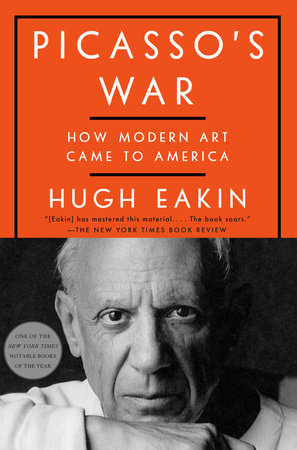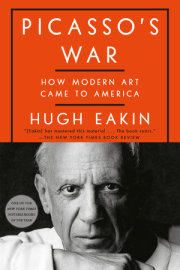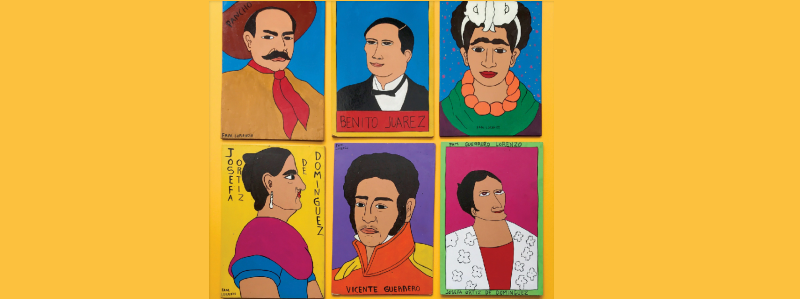PrologueThe painting was in the corridor with its face to the wall. Measuring more than four feet high and nearly seven feet across, its huge rectangular frame beckoned, and all four guests were eager to see it. But they would have to wait. There were Bacardi cocktails to drink, followed by dinner and coffee. As they gathered in the front rooms of the cavernous ninth-floor apartment, they somehow needed to find other things to talk about. John Quinn would not be rushed in his own home. A tall, fair-complexioned man with a sharp jawline, piercing blue eyes, and a pronounced forehead in front of a balding crown, their host was an almost physical embodiment of the strength of will. Even his assertive posture appeared to be at war with his hollowed-out frame.
At last, after the coffee was served, Quinn rose from the table, stepped out to the hallway, took the painting to the drawing room, and set it up on a large easel under good lighting. Then he returned and poured each of his guests a glass of prewar champagne. It was time. Carrying their glasses, they followed him in.
From the outset, the dinner had stirred up expectation. It was the early spring of 1924, and for months, the hard-charging Wall Street lawyer had not entertained. At the start of the year, he had sold off much of his incomparable collection of modernist manuscripts—including the first drafts of nearly all of Joseph Conrad’s novels and the twelvehundred-page original text of James Joyce’s
Ulysses. And in recent weeks, Quinn had mostly suspended the vast personal correspondence he kept with artists and writers across Europe. Among his large New York circle, many had not seen him at all. Now he had abruptly summoned the four of them.
As they glanced at one another around the table, they knew they had not been chosen casually. Arthur B. Davies, painter, aesthete, and society man, was one of the city’s most well-connected champions of modern art. Frederick James Gregg, mordant critic for
Vanity Fair and the New York Sun, had long been one of Quinn’s closest intellectual allies. Joseph Brummer, the Hungarian art dealer who had once swept floors for Matisse in Paris, was one of the very few people in the United States who knew personally many of the artists whom Quinn collected. Rounding out the company was the poet Jeanne Robert Foster, a younger woman with large, inquisitive eyes, a Greek nose, and an unruly mass of reddishblond hair. She was the literary editor of
The Transatlantic Review and was better informed about the art and writing of twentieth-century Europe than almost anyone in Manhattan. Though she was married to another, much older man, she had for several years been Quinn’s lover.
In New York at the time, only a handful of collectors were interested in living artists. Contemporary modern art was deemed to have negligible value, and many found the new colors and techniques abhorrent, or even subversive. Yet over the previous decade, Quinn had filled his eleven-room suite on Central Park West with hundreds of the most startling new artworks in existence. Hallways were cluttered with beguiling marble and polished bronze sculptures, animal and human subjects reduced to their underlying essences; bedrooms were filled with riotous canvases—not hung up, but lining the walls in thick rows, stacked under chairs, and stuffed under beds. When Quinn was in the right mood, he would bring out any number of remarkable paintings, works that challenged the imagination of his visitors: Cézannes and Van Goghs, Gauguins and Seurats, Fauvist landscapes, Futurist dancers, Vorticist women. There was an exceptional clutch of Matisses, including one that had provoked a violent backlash a few years earlier. And of course the Picassos, several dozen of them, spanning from his early
Old Guitarist to exquisite forays into analytical Cubism to his late Cubist masterpiece
Harlequin with Violin (Si tu veux) and encompassing all the contrasting phases of his art.
Even by Quinn’s standards, however, the painting that awaited them that night was out of the ordinary. In Paris, where it had turned up in a basement six weeks earlier, it had shocked and overwhelmed several of the leading connoisseurs of the new art; though its history remained obscure, there was talk of it going straight to the Louvre. In the United States, no one had known of its existence.
No one except Quinn. Picasso had been one of the first to see the mysterious painting, and he had immediately thought of his American friend. Two weeks later, Quinn had bought it, for a modest sum, without leaving New York, without ever seeing it. Picasso’s judgment, and the fervent appeals of Quinn’s other Paris friends, had been enough. They knew he had been hunting for such a singular painting for years; they felt certain this was the one. Having crossed the ocean on the
S.S. Paris in a large crate, the very large work had been delivered to Quinn’s apartment shortly before his guests arrived. Before the dinner, he had unwrapped it. But he hadn’t inspected it, until now.
As they entered the room, Quinn’s dinner companions were seized by the giant rectangle. Confronting them was a nocturnal encounter as alluring as it was strange: A serene, dark-complexioned woman slumbers on a barren desert ridge; as she sleeps, a huge lion approaches her and sniffs her hair, its upturned tail silhouetted against the cool night air. The two seem to be in remarkable communion, even as the beast menaces.
Overpowering in its tension and equipoise, the painting was unlike any they had seen. For sheer mastery of its human and animal forms, spareness of detail, and uncanny rhythm and balance, the giant canvas was astonishing. But it was also filled with unsettling mystery. It was hard to tell, Quinn observed, whether the lion was going to devour the woman or not. For some time, they stood looking at it. Eventually, Davies called it “wondrous.” Then they raised their glasses. “To beauty,” someone said.
Quinn was a man not easily pleased. He’d turned down Seurats and Van Goghs that European rivals had coveted. He had passed up countless Braques and Matisses, preferring to wait for better ones. At times, he’d rejected Picassos that the artist himself had offered him. Sometimes he’d sent paintings back that he found wanting. Up until the moment he saw it, his friends in Paris were worried about this one, too. They needn’t have been. “The painting sings, every part of it, and the whole of it is perfect,” he wrote the next morning.
Called
The Sleeping Gypsy, the painting was by Henri Rousseau, the French customs official and self-taught artist who had died in 1910. Though he remained little known to the general public, he was a lodestar to Picasso and other avant-garde painters, who befriended him at the end of his life. Quinn had long been fascinated by Rousseau’s unworldly genius. He also knew that his paintings were widely scattered. Years earlier, he had set out to acquire a work of Rousseau’s that stood out above all the others. He was convinced that such a picture existed, but none of the Rousseaus he saw measured up. Until Picasso found him the woman and the lion.
For Quinn, the painting’s arrival in his apartment was the climax of a career as a cultural renegade, a life lived through the most daring art and literature of his time. Though he seldom traveled to Europe, Quinn had made friends with, and personally supported, an improbable number of the artists and writers who would go on to define modernism, picking them out, on his own judgment, because they excited him: Joseph Conrad and Henri Matisse, Ezra Pound and Pablo Picasso. He had followed them through the war, sent them letters and money, visited their studios and flats, worried about their health. Even as he struggled to keep up with his law practice, as his own health declined and he ran out of funds, he always found time for what he adamantly referred to as
living art. The paintings and sculptures that moved him most were not just objects of uncommon beauty; they had to give off “radium,” he told his friends, the energizing rays of life itself.
Nor had he been content to keep his enthusiasms private. At a time when modern art remained deeply suspect to most Americans, Quinn aggressively promoted avant-garde painting and modernist prose. He introduced Americans to the poetry of W. B. Yeats and T. S. Eliot, to Romanian sculptor Constantin Brancusi’s
Mlle Pogany and to French artist Marcel Duchamp’s
Nude Descending a Staircase. He defended taboo-breaking novels in court and lobbied Congress to end a punitive import tax on contemporary art. The best new work, he argued, was inseparable from social progress, and introducing it to a broad public would bring American civilization to the forefront of the modern world.
Six years earlier, at the end of the war, he had embarked on an even more ambitious project: to gather together the very best works by the small group of artists who, in his estimation, were changing history. With these unheralded masterpieces, he was going to build the first great modern art collection in the United States. And he was going to transform the way Americans thought about art. With his Picassos, and now the big Rousseau painting, he seemed, at last, to be bringing that project to fruition.
Copyright © 2022 by Hugh Eakin. All rights reserved. No part of this excerpt may be reproduced or reprinted without permission in writing from the publisher.







